
Randall V. Mills (1907-1952) was a professor of literature with a variety of interests related to the Pacific Northwest, including steamboats, railroads and folklore.

Randall V. Mills (1907-1952) was a professor of literature with a variety of interests related to the Pacific Northwest, including steamboats, railroads and folklore.
Randall was born in Wisconsin in 1907. In 1929 Mills received his undergraduate degree from the University of California, Los Angeles (UCLA). His master's degree was received from University of California, Berkeley in 1932.
He became part of the University of Oregon English faculty in 1938. Mills had a variety of interests. One of his main interests was in the history of transportation in the Pacific Northwest, especially steamboats and railroads. He was also interested in all aspects of covered bridges. Another subject for which Mills showed enthusiasm was folklore, particularly proverbs, dialects, songs, superstitions and place names. [1]
He was the founder and first president of the Oregon Folklore Society. [2] He served as Director for the Oregon branch of the American Dialect Society, he also chaired the state sub-committee for the collection of dialect sayings. He held the position of associate editor for Western Folklore. Mills died in 1952 at the age of 44.
The University of Oregon named its folklore archives in honor of Mills. The Randall V. Mills Archives of Northwest Folklore, established in 1966, serve as a repository for information collected in Oregon by scholars and students of folklore. The archives are the largest facility of their kind in the Pacific Northwest of the United States. [3] During his life, Mills assembled a collection of photographic negatives and prints of photographs depicting covered bridges and steamship captains in Oregon and railroad locomotives and cars in the western United States. This collection is now held by the University of Oregon. [4]

The Oregon Railroad and Navigation Company (OR&N) was a railroad that operated a rail network of 1,143 miles (1,839 km) running east from Portland, Oregon, United States, to northeastern Oregon, northeastern Washington, and northern Idaho. It operated from 1896 as a consolidation of several smaller railroads.
The Shaver Transportation Company is an inland water freight transportation company based in Portland, Oregon, United States. The company was founded in 1880 and played a major role in the development of freight transport in the Portland area and along the Columbia.

Many steamboats operated on the Columbia River and its tributaries, in the Pacific Northwest region of North America, from about 1850 to 1981. Major tributaries of the Columbia that formed steamboat routes included the Willamette and Snake rivers. Navigation was impractical between the Snake River and the Canada–US border, due to several rapids, but steamboats also operated along the Wenatchee Reach of the Columbia, in northern Washington, and on the Arrow Lakes of southern British Columbia.
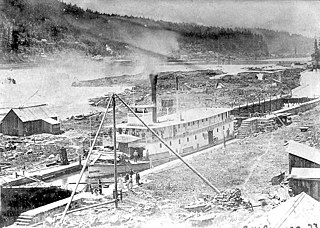
The Willamette River flows northwards down the Willamette Valley until it meets the Columbia River at a point 101 miles from the Pacific Ocean, in the U.S. state of Oregon.

The history of steamboats on the Oregon Coast begins in the late 19th century. Before the development of modern road and rail networks, transportation on the coast of Oregon was largely water-borne. This article focuses on inland steamboats and similar craft operating in, from south to north on the coast: Rogue River, Coquille River, Coos Bay, Umpqua River, Siuslaw Bay, Yaquina Bay, Siletz River, and Tillamook Bay. The boats were all very small, nothing like the big sternwheelers and propeller boats that ran on the Columbia River or Puget Sound. There were many of them, however, and they came to be known as the "mosquito fleet."

The steamship Altona operated from 1890 to 1907 on the Willamette River in the U.S. state of Oregon. In 1907, she was transferred to Alaska.
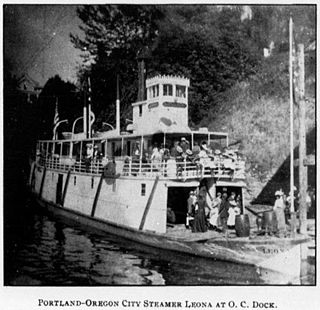
The steamship Leona operated from 1899 to 1912 on the Willamette River in the U.S. state of Oregon. This vessel was original launched under the name McMinnville in 1899, and should not be confused with an earlier vessel named McMinnville, which ran on the Willamette River from 1877 to 1881.

Nez Perce Chief was a steamboat that operated on the upper Columbia River, in Washington, U.S., specifically the stretch of the river that began above the Celilo Falls. Her engines came from the Carrie Ladd, an important earlier sternwheeler. Nez Perce Chief also ran up the Snake River to Lewiston, Idaho, a distance of 141 miles from the mouth of the Snake River near Wallula, Wash. Terr.

The river sternwheeler Ramona operated from 1892 to 1908 on the Willamette River in Oregon, on the Stikine River running from Wrangell, Alaska into British Columbia, and the Fraser River, in British Columbia. This vessel should not be confused with the coastal steamship Ramona which also ran in Alaskan waters.

The Multnomah was one of the first steamboats to operate on the Willamette and Yamhill rivers. This vessel should not be confused with the Multnomah, a steamboat built in Portland, Oregon in 1885, which was larger and of a much different design.
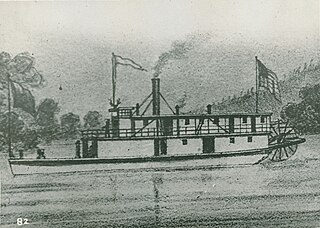
Elk was a stern-wheel driven steamboat built on the Willamette River in 1857 at Canemah, Oregon. This steamboat is chiefly remembered for its destruction by a boiler explosion in which by good fortune no one was seriously hurt. A folklore tale later arose about this disaster.

The steamboat Oregona operated on the Willamette River, the Columbia River and the Yamhill River from 1904 to 1936. From 1924 to 1936 this vessel was known as the Interstate.

Grey Eagle was a wooden sternwheel-driven steamboat that operated on the Willamette and Yamhill rivers in the United States from 1894 to 1930. In 1903 Grey Eagle became the last commercial steamboat to run upriver to Junction City, Oregon.
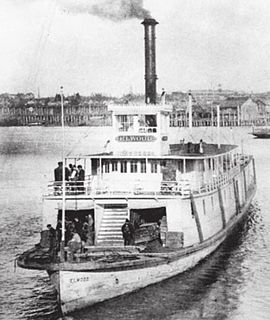
Elwood was a sternwheel steamboat which was built to operate on the Willamette River, in Oregon, but which later operated on the Lewis River in Washington, the Stikine River in Canada, and on Puget Sound. The name of this vessel is sometimes seen spelled "Ellwood". Elwood is probably best known for an incident in 1893, when it was approaching the Madison Street Bridge over the Willamette River in Portland, Oregon. The bridge swung open to allow the steamer to pass. However, a streetcar coming in from the east end of the bridge failed to notice the bridge was open, and ran off into the river in the Madison Street Bridge disaster.

Minnehaha was a sternwheel-driven steamboat which was built in 1866 on Oswego Lake, then known as Sucker Lake, in Oregon, United States. Minnehaha was later transferred to the Willamette and Columbia rivers where it operated for the first part of the 1870s.
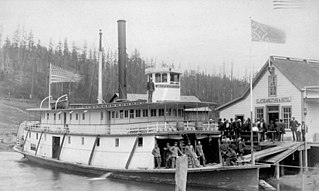
Manzanillo was a stern-wheel driven steamboat built at Portland, Oregon in 1881. Manzanillo was first run on the Columbia River route from Portland to Clatskanie, Oregon and way points along the river. The initial owner of the boat was the People's Freighting Company, but the Shaver family soon acquired control of the vessel, which became the first vessel of what is now Shaver Transportation Company.

Relief was a stern-wheel steamboat that operated on the Columbia and Willamette rivers and their tributaries from 1906 to 1931. Relief had been originally built in 1902, on the Columbia at Blalock, Oregon, in Gilliam County, and launched and operated as Columbia, a much smaller vessel. Relief was used primarily as a freight carrier, first for about ten years in the Inland Empire region of Oregon and Washington, hauling wheat and fruit, and after that was operated on the lower Columbia river.
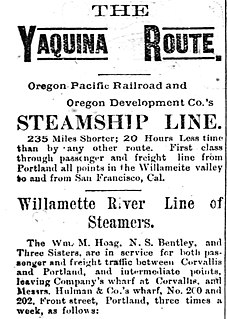
N.S. Bentley, commonly referred to as simply Bentley, was a stern-wheel driven steamboat that operated on the Willamette rivers. Launched in East Portland in December 1886, Bentley ran until 1896, when it was rebuilt and renamed Albany. Bentley was owned by the Oregon Pacific Railway, and was used as part of a rail and marine link from Portland to San Francisco, running down the Willamette, then to Yaquina Bay, and then by ocean steamer south to California. In 1896, Bentley was rebuilt and renamed Albany.

Nahcotta was a steamboat operated from 1898 to 1928 on a route from Astoria, Oregon to Ilwaco, Washington, and then, from 1908 on, from Astoria to Megler, Washington. Nahcotta ran on the same route for its entire service life, and for much of that time was commanded by Capt. Tom Parker, who started his marine career as a deckhand and who had only three months of formal education.

Kuskanook was a wooden, stern-wheel driven steamboat that operated on Kootenay Lake, in British Columbia from 1906 to 1931. After being taken out of service, Kuskanook was sold for use as a floating hotel, finally sinking in 1936. The vessel name is also seen spelled Kooskanook.